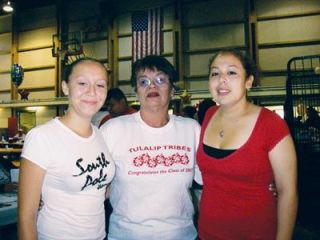TULALIP Back to school meant a lot more to students at Tulalip Heritage High School this fall, so leaders got together to hold a welcome feast for school and community members last week.
With an enrollment double the size of last year, students wanted to reach out to each other and almost 200 others with food and fellowship to kick the year off right. The Back to School Feast was held Sept. 7 in the Tulalip Tribal center gymnasium, where tables were groaning with a bounty provided by students. Anyone was welcome for the gratis grub and student leader Jennifer Cordova-James said she was hoping to get 250 people to attend and learn more about the Marysville School Districts smallest high school.
Were giving back to the community and were trying to show that Tulalip Heritage [High School] is more than people think it is, Cordova-James said.
The back to school feast has been held once before, in the Boys and
Girls Club next to the high school, but moved to the Tribal center to accommodate the larger crowd. The high school has doubled in size after more people were aware of the option as a smaller learning community, according to principal Martha Fulton. Its a Marysville School District program hosted on the Tulalip Indian Reservation, with lots of support from the Tulalip Tribes, but is open to non-tribal members as well. Tulalip Heritage will be moving to a new facility next to Quil Ceda Elementary School later this school year, providing more room for growth.
That means kids will have to work harder to maintain the intimacy theyve gotten used to. Just organizing the feast brought many of the students together in a logistics exercise that tapped into their energy, resourcefulness and teamwork. They broke into five teams to work on different areas including budgets, publicity, setting up the venue and getting and cooking the food. Fulton said they had a firm budget of $500 to work with, and they were counting every penny as they cruised through the grocery store.
The bill was $500.98, Fulton laughed. This is amazing this is something weve dreamed about. Theyve done everything to share with the community.
This year students will have to complete a senior project to graduate, something other high schools like Marysville Arts & Technology have done for a couple years. Fulton said the experience the Tulalip kids got organizing the feast should pay off.
This feast is an example of the projects students will do, Fulton said.
For senior Eddie Wayne it was a new experience. The Tulalip Indian said the first feast had about 50 guests and this year his job was to get the word out to as many community members as possible. They printed flyers, they taped a promotional announcement for the Tribal television channel, and took the extra step of visiting the homes of Tribal elders to make sure they knew about the event and that they would be welcome.
I learned how to be a leader, Wayne said. When its all on you, you have to do it right.
The feast featured musical performances by The Flowin-Crew, a rap group comprised of several members of the Tulalip Heritage basketball team, The-206-Boys drum corps, as well as prayers and songs by elder Ray Fryberg and a prayer by Sheryl Fryberg.
Marysville School District superintendent Larry Nyland smiled as he surveyed the many tables filled with people eating fried chicken, spaghetti and lots of other favorites. He said that Tulalip Tribes employ about 2,300 people and want to be able to fill those positions with locals as they grow.
We want to make that viable, Nyland said.
One way is to harness the interest of students, finding projects like the feast to let them discover what they are capable of, Nyland said. Tulalip Heritage received a $40,000 grant to learn from other schools with hands on activities. The grant would let the school consider different organizational structures, and would examine the relationships between students and staff. The project-based learning could offer more individualized curricula, he added.
Tulalip Heritage feasts the masses before their classes
TULALIP Back to school meant a lot more to students at Tulalip Heritage High School this fall, so leaders got together to hold a welcome feast for school and community members last week.



